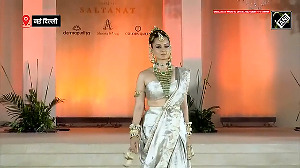In times to come, people will refer to 2007 as the cusp year, that point of transition when India's mobile market changed gear from voice to entertainment, from being a handy tool to a complete office.
Aha, you say, my mobile already does that, thank you, what's the big deal if it moves a bit further along that path? That's development, silly!
But what's not development but a whole leap forward is what you could be doing with your hand-held next year.
You could whip out your mobile phone to check out your favourite late night television series, view the video highlights of the party you went to the previous night and still have a hangover from, take on your office buddy, who works in another office wing, in an exciting FIFA game, use your phone as a jukebox to listen to a streaming audio version of the new Himesh Reshammiya single, then pause the song to take a call from the boss.
And that's just for starters.
Consider this -- and we're only 10 months away from it -- your mobile will work for you even while you sleep. It will set your travel schedule and check for jams along your route, whether you take the car/bus or the train. It will be both your cash and plastic in one, a one-instrument payment system to pay for your tickets and your purchases by simply texting the bank.
It will be your one-stop entertainment box that will hold all your music files, tuned to download programmes that will hold your individual interest while you're on the move or in your spare moments. It will work out what to do with incoming phone calls and messages -- directing voice calls to voicemail when you are in a meeting, for instance, but providing a discreet text summary of the caller and the nature of the call.
All this on 3G.
Third Generation or 3G is a generic term used for the next generation of mobile communication systems coming some time soon to India.
You might have read about it in the papers more in the context of the defence ministry objecting to it on grounds of security, or the players who are or aren't interested in plugging the loop in India.
That's all part of the teething process but make no mistake, it's imminent and will impact the way you live and work sooner rather than later. It already has 350 million subscribers worldwide with 30 million signing up every quarter.
Analysts estimate that by 2010, the two dominant 3G technologies, CDMA2000 and Wideband CDMA (WCDMA), will account for 1.2 billion subscribers, representing 41 per cent of the global subscriber base.
Meanwhile, the world's GSM subscriber base is expected to begin its steady decline in 2008. In India, where 3G should see its sunrise by March 2008, operators are leaving no stone unturned in getting the technology right.
Gartner Dataquest, which helps technology vendors collect and interpret critical IT and telecom market data, feels that 54 per cent of global telecom spending in 2006-07 will be directed towards building CDMA2000 and WCDMA infrastructure.
In 2007, the research firm expects global telecom spending to be nearly 61 per cent for 3G infrastructure, as spending on 2G technologies like GSM continues to decline.
Strategy Analytics, another research agency, notes that since half of global spending for 3G wireless infrastructure went to CDMA-2000 and WCDMA during 2006, it implies a straight decline on 2G technology investments.
"Indian operators have committed significant investments on 3G technologies like CDMA2000 1x evolution-data optimised (EV-DO) and WCDMA, to provide increased network capacity at a lower cost for delivering voice, multimedia and broadband data," explains Tom Phillips, government and regulatory affairs officer, GSM Association.
Interestingly, of the 165 million-odd Indian mobile subscribers,
CDMA claims only 45 million subscribers, the rest comprising of GSM subscribers. Does this mean GSM operators can expect a headstart? Provided the spectrum is allocated, as it is currently meant to, by end-2007, GSM majors like Bharti are not ruling out a quick launch.
Don Price, director (networks), Bharti Airtel, is making sure they are able 'to launch 3G in a short time after the allocation of the spectrum process is concluded'. Price maintains 'a seamless handoff between 2G and 3G networks. So, practically speaking, the 2G/3G combined network should be able to address all the wireless voice and data requirements of Indian customers'. Arguably, there are 302 million
CDMA2000 customers globally, which is approximately 75 per cent of the 3G market today, as per a report by CDMA Development Group (CDG). Pankaj Sethi, president (value added services), Tata Teleservices, reiterates this: "In the precinct of 3G technologies like CDMA2000, we can be hopeful of taking our data revenues to 10-12 per cent, that translates into healthy profits."
So operators are working to make mobile phones more like a remote control for your life. "You still call it a 'mobile' from habit, but it will evolve into an organiser, entertainment device, payment device and security centre," surmises Sethi.
Over the last six years, globally, 300 operators have deployed 3G systems. Indeed, CDMA2000 has a clear lead in the 3G market and maintains an 80 per cent share of all 3G subscribers. With 166 operators running CDMA2000 networks in 73 countries and adding 8.5 million new users each month, CDMA2000 is on track to reach 350 million subscribers by the end of this year.
Still, says Arpita Pal Agrawal, associate director, PricewaterhouseCoopers (PwC), "3G's efficient rollout, by both CDMA and GSM operators, will depend on the price they pay for obtaining licences and the cost they levy on consumers. Handset availability will also be a deciding factor in this 3G tussle."
Telecommunications equipment and network solution providers like Huang Dabin, CEO of ZTE India, are bullish. The company's India contract sales in 2006 were $600 million, the 2007 target is set at $800 million.
"We have revised our 2008 target to $1000 million in the Indian market."
ZTE equipment already accounts for 85 per cent of BSNL's CDMA market; it has undertaken Tata's national rural telecom project and is helping Reliance expand its CDMA network at the speed of 1 million new users per month.
Forget for the moment the service providers, what will you be looking for on your 3G smart phones? From downloading music to accessing and editing e-mails on the mobile handset, from watching television to visual chatting what services will you want and be willing to pay for?
According to Sanjiv Mital, CEO, Bharti Telesoft (the software arm of Bharti Enterprises) "paying a premium" for services won't be a big deal for consumers - "Typically, e-mail and chat are hugely popular and these services will be enhanced in terms of video mail or video chat. If past subscribers are anything to go by, we see a willingness among customers to pay a premium price."
Bharti Telesoft speculates that a bouquet of mobile TV channels could be made available for anywhere between Rs 25-50 a month. Ravi Sharma, head (South Asia), Alcatel-Lucent, a company that has already invested £1 billion in India and has an R&D joint venture with CDoT in Chennai and a Bell Labs research centre in Bangalore, punctures that confidence with a note of caution, "We can't afford 3G services to be too expensive."
The reason for the obsession with mobile TV is logical -- vendors (like Nokia, Samsung, Motorola) will inherently promote services that favour network and handset upgrades, fueling vendor sales. Mobile TV has been the weapon vendors have hyped to get operators to keep upgrading their networks.
The reason is clear -- of all the rich media services, streaming generally, and mobile TV specifically, place the greatest demand on the operator network, causing operators to upgrade quickly. Mittal estimates that, revenue wise, video contributes 15-25 per cent of multimedia downloads in India, "These are short 10-20 second clips. 3G is all about better bandwidth and a thicker pipe that allows transfer of data at higher speed, and we can easily expect heavier files against the 20 second clips."
A few trends are clear: mobile television and e-mail access on a mobile handset definitely figure among the more popular applications. Agrees Dr Nikhil Jain, chief technology advisor, Qualcomm India, "Applications with access to the Internet, such as e-mail, are bound to be popular in the 3G realm."
Jain is betting heavily on interactive learning and Yellow Pages-like help services. For a rural user, that could translate to access to local weather reports, farming updates or even medical and educational aids. Qualcomm hopes that rural connectivity will come of age with 3G.
"Men and women could probably seek visually interactive medical aid over their mobile phones at the press of a button, maybe even talk to a medical representative sitting in the neighbouring district just the way we talk to a customer care executive."
Neha Gupta, senior research analyst at IT research and advisory firm Gartner, adds a word of caution: "Wireless data revenues are just about picking up, the industry averages 10 per cent of the total revenues (22 per cent in the next five years), but we don't expect applications like navigation tools or location-based marketing to take off yet, not in the next five years."
Agrees Romal Shetty, director, KPMG, "Even today the most popular applications are text messaging (SMS), followed by web and WAP access and content downloads, with 50 per cent mobile subscribers using these basic data services."
Shetty and Gupta foresee 10-20 per cent growth in 3G services like news, music, games, ticker services, streaming music, weather, videos, movies or audio books.
For mobile content developers like India-games, calculating numbers is not a priority. They are content that mobile phones will transform into a device good enough to offer console class gaming. Vishal Gondal, CEO of Indiagames, is betting on 'interactive gaming' but worries about getting the pricing right.
"Maybe a little more than the current Rs 50 could work," he guesses.
Mobile games see close to 200 million downloads today, 'more from the CDMA subscribers'.
Gondal expects the trend to continue within the 3G expanse. Juniper Research, a telecom analyst firm, pegs worldwide mobile gaming revenues, composed of casino-like games, sports betting and lotteries, to touch $19.3 billion by 2009. It expects mobile gaming to make up roughly a third of the entire estimated $60 billion mobile entertainment market for that year.
Location-based marketing is also expected to trigger off a marketing model for cash-strapped operators by offering prepaid customers additional minutes as long as they watch online ads, answer questions by SMS or fill out surveys about products and services. There's merit, therefore, in Jain's suggestion that 'Indian subscribers could charge mobile marketers for the customer base instead of passing the cost down to the customers. This way, the costs can be managed at marginal prices'.
However, navigation tools don't have too many takers in the industry. "It's too soon to think of Global Positioning Systems," opines Gartner analyst Neha Gupta.
Simply put, if one has to meet a friend for a quick beer, Indian subscribers won't have the liberty to send a text message with their GPS-enabled hand phone (which can map the exact location coordinates of the message sender to the recipient). This, in return, can pinpoint the sender's location on a map and calculate the best route for the recipient to take.
The immediate problem is with most subscribers still using their phones for voice operations, and devices based on price rather than their multimedia functions. This could be the deterrent in 3G's rapid absorption, feels Shetty. "But selling an HSDPA or 3G phone with cutting-edge multimedia features is a tough marketing call with average 3G handsets likely to cost Rs 15,000-25,000."
Last year, the GSMA Emerging Market Handset programme announced that mobile phone suppliers should compete to design a 3G handset to meet operators' requirements and allow people to take advantage of video clips, mobile music, Internet access and other multimedia services. Its goal is to reduce the wholesale price of entry-level handsets to less than $30, heralding the creation of a new segment of ultra-low cost phones that support 3G services.
"It's the only logical evolution," says Agrawal of PwC. Ready or not and right-priced or not, picture sharing, mobile blogging and mobile banking is set to get a thumb's up, and operators are all set to provider faster Internet browsing and e-mail services. Content providers are going hysterical at the thought that handhelds will be the only entertainment screen for millions of Indians, garnering an enormous demand for mobile content.
As for us subscribers - we can sit back and let the telecom industry woo us. In style.






